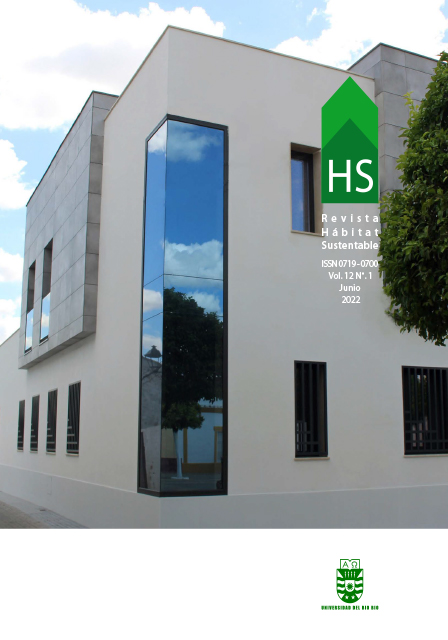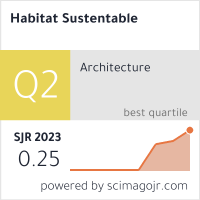Optimización multiobjetivo de la eficiencia energética y el confort térmico en edificios de oficina públicos. Periodo crítico de verano en la ciudad de San Juan, Argentina
DOI:
https://doi.org/10.22320/07190700.2022.12.01.07Palabras clave:
optimización en edificios, ahorro energético, confort interiorResumen
El 40% de la demanda mundial de energía y de emisiones de CO2 proviene de las edificaciones. En Argentina, los edificios son también responsables del 40% del consumo total anual de energía. El problema radica en el desequilibrio provocado entre la necesidad de proveer de una elevada calidad de vida y confort a los espacios de oficina y el costo de energía requerido para acudir a tal propósito. Tanto un alto nivel de confort como el ahorro energético representan dos objetivos a alcanzar. En ese sentido, este artículo propone una nueva metodología que combina la medición in situ con herramientas de simulación matemática. Se incorporan técnicas y modelos innovadores para la elaboración de la herramienta aplicando una optimización multiobjetivo termo-energética, que opera dinámicamente durante el horario laboral. Los resultados muestran un importante ahorro en el consumo energético para refrigeración de espacios de oficinas en verano (del 57,5% al 83,3%), junto con un aumento en la calidad del confort térmico de entre el 4,7% y el 29,4%.
Descargas
Citas
ABDOU, N., MGHOUCHI, Y. E., HAMDAOUI, S., ASRI, N. E. y MOUQALLID, M. (2021). Multi-objective optimization of passive energy efficiency measures for net-zero energy building in Morocco. Building and Environment, 204. DOI: doi.org/10.1016/j.buildenv.2021.108141
ARBALLO, B. D. (2020). Eficiencia Energética y Confort Térmico adaptativo-variable en espacios de oficina mediante Optimización Multiobjetivo. Tesis doctoral. Facultad de Arquitectura, Urbanismo y Diseño. Universidad Nacional de San Juan.
ASHRAE Standard 55 (2004). Thermal environmental conditions for human occupancy. Atlanta: American Society of Heating, Refrigerating and Air-Conditioning Engineers.
ATTHAJARIYAKUL, S. y LEEPHAKPREEDA, T. (2005). Neural computing thermal comfort index for HVAC systems. Energy conversion and management, 46(15-16), 2553-2565. DOI: doi.org/10.1016/j.enconman.2004.12.007
BLIUC, I., ROTBERG, R. y DUMITRESCU, L. (2007). Assessing thermal comfort of dwellings in summer using EnergyPlus. En Proc. of the CLIMA 2007 World Congress “Well Being Indoors”.
BOERSTRA, A. C., VAN HOOF, J. y VAN WEELE, A. M. (2015). A new hybrid thermal comfort guideline for the Netherlands: background and development. Architectural Science Review, 58(1), 24-34. DOI: doi.org/10.1080/00038628.2014.971702
BRE, F. y FACHINOTTI, V. D. (2017). A computational multi-objective optimization method to improve energy efficiency and thermal comfort in dwellings. Energy and Buildings, 154, 283-294. DOI: doi.org/10.1016/j.enbuild.2017.08.002
BRE, F., ROMAN, N. y FACHINOTTI, V. D. (2020). An efficient metamodel-based method to carry out multi-objective building performance optimizations. Energy and buildings, 206. DOI: doi.org/10.1016/j.enbuild.2019.109576
CHAMBERS, L. D. (2000). The practical handbook of genetic algorithms: applications. New York: Chapman and Hall/CRC. DOI: doi.org/10.1201/9781420035568
CHANDEL, S. S., SHARMA, V. y MARWAH, B. M. (2016). Review of energy efficient features in vernacular architecture for improving indoor thermal comfort conditions. Renewable and Sustainable Energy Reviews, 65, 459-477. DOI: doi.org/10.1016/j.rser.2016.07.038
COELLO, C. A. C., VAN VELDHUIZEN, D. A., y LAMONT, G. B. (2002). Evolutionary algorithms for solving multi-objective problems (Vol. 242). New York: Kluwer Academic.
EnBop (2008). Energie Betriebsoptimierung. Recuperado de http://www.enob.info.
EPRE (2017). Datos de consumo de energía proporcionados por el Ente Provincial Regulador de Energía. San Juan, Argentina.
ISO 7730 (2005). Ergonomics of the thermal environment-Analytical determination and interpretation of thermal comfort using calculation of the PMV and PPD indices and local thermal comfort criteria. ISSO. Rotterdam, Holanda.
ISSO 74 (2004). Thermische Behaaglijkeid. Publication 74, ISSO. Rotterdam, Holanda.
KUCHEN, E. (2008). Spot-Monitoring zum thermischen Komfort in Bürogebäuden. Tesis de Doctorado. Tönning, Deutschland: Der Andere Verlag.
KUCHEN, E., ALONSO-FRANK, A., ALAMINO-NARANJO, Y., ARBALLO, B., GALDEANO, M. y ACCOLTI, E. (2016). Eficiencia Energética en Edificios Públicos. En VIII Congreso Regional de Tecnología de la Arquitectura–CRETA (19 al 21 de octubre). San Juan, Argentina.
LI, Q., ZHANG, L., ZHANG, L. y WU, X. (2021). Optimizing energy efficiency and thermal comfort in building green retrofit. Energy, 237. DOI: doi.org/10.1016/j.energy.2021.121509
LU, L., CAI, W., XIE, L., LI, S. y SOH, Y. C. (2005). HVAC system optimization—in-building section. Energy and Buildings, 37(1), 11-22. DOI: doi.org/10.1016/j.enbuild.2003.12.007
NGUYEN, A. T., REITER, S. y RIGO, P. (2014). A review on simulation-based optimization methods applied to building performance analysis. Applied Energy, (113), 1043-1058. DOI: doi.org/10.1016/j.apenergy.2013.08.061
Norma IRAM 11603 (2012). Clasificación bioambiental de la República Argentina. Buenos Aires: Instituto Argentino de Normalización y Certificación.
RUPP, R. F., KIM, J., DE DEAR, R. y GHISI, E. (2018). Associations of occupant demographics, thermal history and obesity variables with their thermal comfort in air-conditioned and mixed-mode ventilation office buildings. Building and Environment, 135, 1-9. DOI: doi.org/10.1016/j.buildenv.2018.02.049
RUPP, R. F., VÁSQUEZ, N. G. y LAMBERTS, R. (2015). A review of human thermal comfort in the built environment. Energy and Buildings, 105, 178-205. DOI: doi.org/10.1016/j.enbuild.2015.07.047
SÁNCHEZ-GARCÍA, D., RUBIO-BELLIDO, C., MARRERO-MELÉNDEZ, M., GUEVARA-GARCÍA, F. y CANIVELL, J. (2017). El control adaptativo en instalaciones existentes y su potencial en el contexto del cambio climático. Revista Hábitat Sustentable, 7(2), 06-17. DOI: doi.org/10.22320/07190700.2017.07.02.01
SCHLUETER, M., WAHIB, M. y MUNETOMO, M. (2021). New State-of-the-Art Results on ESA’s Messenger Space Mission Benchmark. In Advances in Parallel & Distributed Processing, and Applications (pp. 669-681). Springer, Cham.
STANISLAV, H. Z. (2003). Systems and Control. Nueva York: Oxford University Press.
TORANZO, E., KUCHEN, E. y ALONSO, A. (2012). Potenciales de eficiencia y confort para un mejor funcionamiento del edificio central de la universidad nacional de San Juan. Avances en Energías Renovables y Medio Ambiente-AVERMA, 16, 157-164.
VAN HOOF, J., MAZEJ, M. y HENSEN, J. L. M. (2010). Thermal Comfort: Research and Practice. Frontiers in Bioscience, 15(2), 765–788.
YUAN, Y., YUAN, J., DU, H. y LI, L. (2012). An improved multi–objective ant colony algorithm for building life cycle energy consumption optimisation. International Journal of Computer Applications in Technology, 43(1), 60-66.
Descargas
Publicado
Cómo citar
Número
Sección
Licencia
Derechos de autor 2022 Bruno Damián Arballo, Ernesto Kuchen, Daniel Chuk

Esta obra está bajo una licencia internacional Creative Commons Atribución-CompartirIgual 4.0.
El contenido de los artículos que se publican en cada número de Hábitat Sustentable, es responsabilidad exclusiva de los autores y no representan necesariamente el pensamiento ni comprometen la opinión de la Universidad del Bío-Bío.
Los autores/as conservarán sus derechos de autor y garantizarán a la revista el derecho de primera publicación de su obra, el cuál estará simultáneamente sujeto a la Licencia de Reconocimiento de Creative Commons CC BY-SA que permite a otros compartir-copiar, transformar o crear nuevo material a partir de esta obra con fines no comerciales, siempre y cuando se reconozcan la autoría y la primera publicación en esta revista, y sus nuevas creaciones estén bajo una licencia con los mismos términos.











 Programa de Información Científica/Concurso Fondos de Publicación de Revistas Científicas 2018/ Proyecto Mejoramiento de Visibilidad de Revistas UBB (Código:FP180007)
Programa de Información Científica/Concurso Fondos de Publicación de Revistas Científicas 2018/ Proyecto Mejoramiento de Visibilidad de Revistas UBB (Código:FP180007) 





